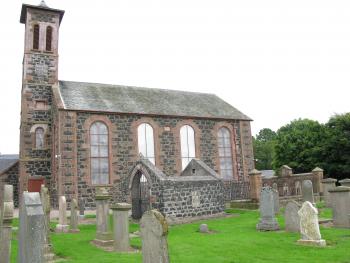- Navigation:
- Back to the Corpus index page
- RSS
Rattray Parish Church
Rattray Church and burial enclosures
- Dedication: unknown
- Diocese of Dunkeld
- Deanery of Angus
- County of Perthshire
- Perth and Kinross Council
- NO 1898 4570
Summary description
Rattray’s parish church, which dates from 1820-21, was built to the designs of the elder William Stirling. Nothing remains visible of the medieval church.
Historical outline
Dedication: unknown
According to Alexander Myln in his Vitae Dunkeldensis Ecclesiae Episcoporum, the church of Rattray had been assigned in the mid-twelfth century by Bishop Gregory as the prebend of the succentor or sub-chanter of Dunkeld.(1) Ian Cowan noted that it appears only as a simple prebend in Bagimond’s Roll in 1274 and in a papal letter of 1345,(2) but it should be pointed out that only the four principal dignitaries of the cathedral – dean, chancellor, treasurer and precentor – have specifically identified prebends listed in Bagimond and that the precentor’s prebend does not appear in the second year of taxation but the church annexed to it, Kinclaven, does. The failure to list Rattray as the sub-chanter’s prebend should not, therefore, be viewed as casting doubt on the validity of Myln, and the parsonage was certainly annexed to his prebend in the sixteenth century.(3) The cure of Rattray was served by a vicarage perpetual.(4)
Notes
2. Cowan, Parishes, 169; SHS Misc, vi, 48, 73; CPL, iii, 149.
Architectural analysis
The author of the entry in the Statistical Account, published in 1792, had complained that the church was old and in poor repair; thirty years later, in 1820-1, it was rebuilt to the designs of the elder William Stirling. It is a rectangular structure with four round-arched windows along its south face towards the churchyard, and a meagre Italianate bell tower at the west end. There is nothing to indicate that any part of its medieval predecessor has been retained in its fabric. It might be considered as a possibility that the church had been to the south of the present building, where there are now the mausoleum of the Whitson of Parkhill family and the burial enclosure of the Clark Rattray of Rattray family, but this could be no more than speculation in our present state of understanding.
Bibliography
Calendar of entries in the Papal registers relating to Great Britain and Ireland; Papal letters, 1893-, ed. W.H. Bliss, London, iii, 149.
Cowan, I.B., 1967, The parishes of medieval Scotland, (Scottish Record Society), Edinburgh, 169.
Dunlop, A.I., 1939, ‘Bagimond’s Roll, statement of the tenths of the kingdom of Scotland’, Miscellany of the Scottish History Society, vi, 1-77, at 48, 73.
Gifford, J., 2007, The Buildings of Scotland, Perth and Kinross, New Haven and London, 277.
Hay, G., 1957, The architecture of Scottish post-Reformation churches, Oxford, 270.
New Statistical Account of Scotland, 1845, Edinburgh and London, x, 246.
Registrum Magni Sigilli Regum Scottorum, 1882, Edinburgh, ii (1414-1513), no 2597.
Royal Commission on the Ancient and Historical Monuments of Scotland, Canmore database.
Royal Commission on the Ancient and Historical Monuments of Scotland, 1990, North-East Perth, an archaeological landscape, Edinburgh, 88.
Statistical Account of Scotland, 1791-9, ed. J. Sinclair, Edinburgh, iv (1792), 149.
Vitae Dunkeldensis Ecclesiae Episcoporum…Ad Annum Mdxv, 1823, ed. T. Thomson, (Bannatyne Club), Edinburgh, 5.
Map
Images
Click on any thumbnail to open the image gallery and slideshow.






